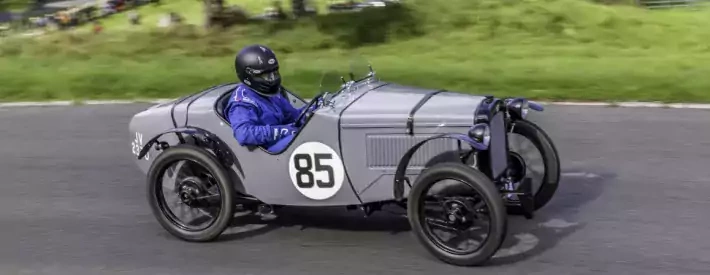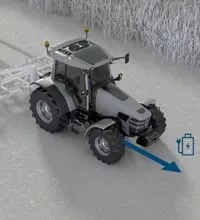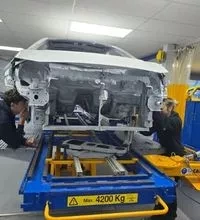The day I raced my 1933 Austin Seven Ulster replica up the Prescott Speed Hill Climb

Some sporting moments have the ability to make the hairs on the back of your neck stand on end. It might be the time you pass through the turnstiles at Wembley or the point where the sun rises behind the grandstands at the Le Mans 24 Hours.
Nestled at the edge of the Cotswolds, the Prescott Speed Hill Climb track has provided many of these moments. Its steep, wooded slopes have been echoing to the sound of racing engines since 1938. Grand prix star and French Resistance hero Jean-Pierre Wimille drove here with the Bugatti works team in 1939 and Stirling Moss began his motor racing career here in 1948. That history hangs in the air.
The first time I came here, it reminded me of wandering up to the barriers at the Nürburgring. That strange feeling of being somewhere you’ve seen in countless photos and videos without ever actually having visited. Now I’m coming back to compete and it feels every bit as surreal.
As someone who grew up watching Vintage Sports-Car Club (VSCC) events, Prescott has always held a near-mystical significance for me. Not only is it arguably the premiere hill climb venue in the UK, it has a history that stretches right back to the birth of the vintage car movement.
The term didn’t exist when the VSCC was founded in 1934. It was originally conceived as a way for less affluent enthusiasts to compete in cars that were considered out of date. In 1937, VSCC member Tom Rolt discovered that the Prescott estate was about to come up for sale so he raised the idea to buy it as a hill climb venue. It was beyond the means of the VSCC but the idea was passed on to the Bugatti Owners Club, which purchased the site and ran its first event in 1938.
Eighty-five years later, there are still strong links between the two organisations. Prescott has become the spiritual home of the VSCC and it continues to attract vintage car enthusiasts from all over the world.
Racing ambition
I finally fulfilled my own ambition of buying a pre-war racing car – a 1933 Austin Seven Ulster replica – two years ago. It was a far cry from the seven-figure sums that some of the cars at Prescott now go for, but it’s been welcomed with open arms. Eighteen months of fettling followed after it transpired that the car wasn’t quite as ‘ready to race’ as I thought it was, but that has only served to make my Prescott debut that little bit sweeter.
The other reason we’re here is to look at the future of vintage cars. While the new car market is rapidly heading towards electrification, that makes limited sense for classic and vintage cars where much of the appeal is down to their visceral nature.
There’s no imminent threat to the supply of petrol for older vehicles and they only account for a tiny percentage of global emissions, but a lot of owners are still keen to embrace sustainability.
With that in mind, we’re running on an 80% sustainable blend from Essex-based Coryton Fuels. Chemically identical to normal petrol, it’s derived from agricultural waste rather than crude oil and claims to reduce greenhouse gas emissions by at least 65%. By my rough calculations, that would put the CO2 emissions of my 90-year old Austin Seven on a par with a mid-size electric vehicle running off a mixed energy grid.
Lights green
We arrive late after a puncture on the tow car and the drivers’ briefing passes in a blur. I’m still trying to process the enormity of what’s happening as our group gets ushered out to form in the assembly area at the bottom of the hill.
The cars are called out in batches and our class is paired with the mighty Edwardians that hark back to the very earliest days of motor racing. Ahead of me is a 1912 Luxior powered by an 8.2-litre Curtiss V8 aero engine. I watch the exposed rocker arms chattering away through the side of the bonnet as it warms up, the Luxior’s exhaust pulses gently pummelling my chest.
Soon it’s time to line up. I see the track sweeping away underneath the iconic Prescott footbridge as I wait for the light to turn green. There’s a chirp from the tyres as I drop the clutch and the engine snarls its way up the rev range before I grab second, sending a rasp from the exhaust on overrun.
I feather the throttle as the car squirms through the first left-hander (I later discover it can be taken flat out with the right line) and we’re soon braking into the long Ettore’s bend. After that, the track dips down before rising up like a wall as you approach the steep and heavily cambered hairpin at Pardon.
It’s then into the trees and the fiendishly tricky s-bends, with the Armco barriers looming close on both sides, before the course thrusts back into the sunshine. We sweep through the final long righthander, with the nose tucking in and the car adopting just the slightest hint of a four-wheel drift. A few seconds later we pass through the chequered pillars of the finish line, elated and buzzing.
The first run had been done on E5 super unleaded pump fuel. I have my suspicions that the engine is running a little rich, but I don’t want to risk upsetting the carburettor settings, so it’s left alone as we drain the tank and switch to the sustainable fuel. I’m curious to see if I can detect any difference.
The subsequent runs don’t reveal any significant change in outright performance, but the engine feels and sounds just that little bit crisper. I later speak to a couple of other competitors running the fuel through the VSCC’s sustainability initiative and they have come to the same conclusion. There doesn’t seem to be any downsides. If this is the future of historic motorsport, it’s looking very bright indeed.
Chris Pickering is a freelance motoring journalist, covering automotive technology, motorsport and car reviews
Image_Dennis Rushton
If you’ve had a journey that has changed your life or made a lasting impression, email james.scoltock@thinkpublishing.co.uk to feature
This is an edited extract from IMI's new MotorPro magazine, received free as part of IMI membership.




